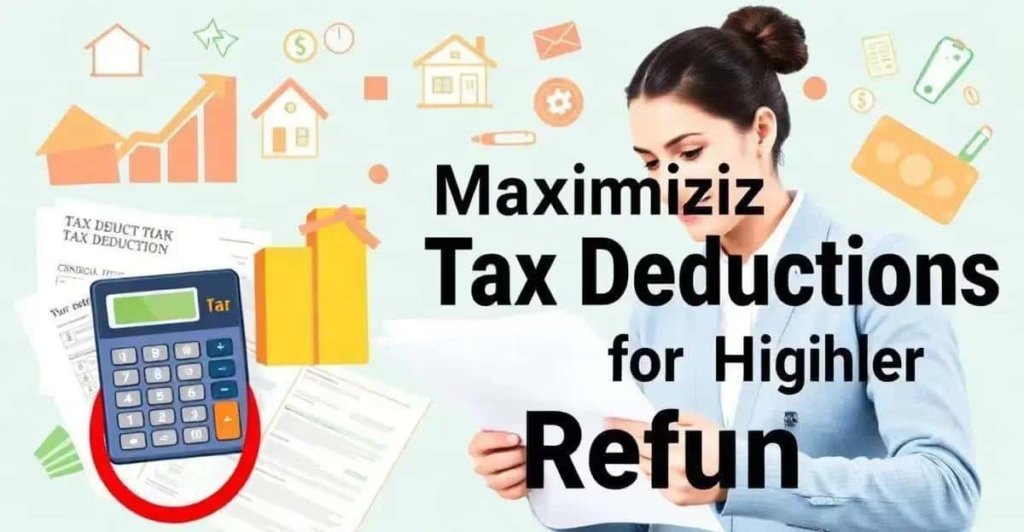As the new year begins, understanding tax breaks is essential. The IRS reports that over 45 million people itemized deductions, claiming $1.2 trillion. Knowing which deductions apply to you can lead to a bigger refund.
Deductions can significantly reduce taxable income, so it’s important to take advantage of them. For example, charitable donations require receipts, and medical expenses must exceed 7.5% of your income to qualify. Being informed and strategic with deductions can help you save more and make smarter financial decisions.
Key Takeaways
- Understanding tax deductions is key to getting more back and paying less in taxes.
- Itemized deductions, like mortgage interest and charitable gifts, can greatly reduce your taxes.
- There are many tax deductions you might not know about, like for education and home businesses. These can save you a lot of money.
- Using tax deductions, like the home office deduction, can make filing taxes easier and lower your taxable income1.
- Knowing about tax deductions and credits helps you make better financial choices and save more.
- Tax deductions, including for medical costs and retirement, can greatly affect your taxable income and overall financial health2.
Understanding Tax Deductions
Reducing taxable income is key to lowering tax bills. Both standard and itemized deductions can help. In 2024, single filers get a $14,600 standard deduction, while married couples filing jointly receive $29,200.
Maximizing available deductions leads to a bigger refund. Eligible expenses include medical costs, mortgage interest, and charitable donations. The Child Tax Credit, for example, provides $2,000 per child, significantly reducing taxes.
Staying organized throughout the year ensures no deductions are missed. Keeping records of expenses and consulting a tax expert can help maximize savings.
| Deduction Type | 2024 Limit |
|---|---|
| Standard Deduction (Single) | $14,600 |
| Standard Deduction (Married Filing Jointly) | $29,200 |
| Mortgage Interest Deduction | $750,000 |

Common Tax Deductions You May Already Know
Exploring tax deductions is key. Knowing the most common ones can save a lot, like for homeowners or those with big medical bills. We’ll look at these deductions, sharing tips on how to use them well, including itemized deduction tips and the home office deduction.
Common deductions include mortgage interest, state and local taxes, and medical expenses. For example, you can deduct up to $10,000 of state and local taxes each year5. Also, you can deduct up to $2,500 of student loan interest in 2023, or what you actually paid, whichever is less6. Remember, these deductions are for tax filing and keeping good records is key.
Here are some important points for these common tax deductions:
- Mortgage interest deductions apply to primary and second homes7.
- You can deduct up to $10,000 of state and local taxes each year5.
- Medical expenses, like doctor visits and prescriptions, can be deducted if they’re more than 7.5% of your income7.
Understanding these deductions and keeping good records can help save money. We’ll keep exploring fiscal deductions and share tips on how to handle taxes.

Education-Related Tax Deductions
Education-related fiscal benefits are key for those in higher education or paying off loans. The Lifetime Learning Credit and Student Loan Interest Deduction can significantly reduce costs. Claiming these can lower taxable income and overall levy liability, keeping more money in your pocket.
It’s also important to consider charitable donation and health expense write-offs. For instance, the Lifetime Learning Credit offers a 20% credit on education expenses up to $10,000, with a maximum benefit of $2,000. The Student Loan Interest Deduction allows up to $2,500 in interest deductions, subject to income limits.
To maximize savings, understanding the rules for these credits is essential. For example, the Lifetime Learning Credit phases out at $59,000 for single filers and $118,000 for joint filers. Staying informed helps you make smart financial decisions and reduce your fiscal obligation.
Key points to consider:
- The American Opportunity Credit provides up to $2,500 per eligible student.
- The Lifetime Learning Credit allows up to $2,000 per tax return, regardless of the number of students.
- Education expenses like tuition, books, and supplies may qualify as deductible work-related costs for self-employed individuals.
By leveraging deductions along with other available credits, you can lower your fiscal burden and stay on track with your financial goals.

Deductions for Home-Based Businesses
Exploring tax deductions is key for home-based businesses. A good tax preparation checklist helps entrepreneurs use many deductions. This includes business expense write-offs and tax breaks 2025. The IRS says you need to use a part of your home only for business to qualify for the home office deduction10.
There are two ways to figure out your home office deduction. You can use the simplified method, which lets you deduct $5 per square foot up to 300 square feet. This could mean a maximum deduction of $1,50010. Or, you can use the regular method, which bases the deduction on how much of your home you use for business. For example, if your home office is 75 square feet in a 1,000 square foot home, you can deduct 7.5% of your home’s expenses10.
Some important deductions for home-based businesses include:
- Home mortgage interest
- Real estate taxes
- Utilities
- Insurance
- Home office expenses, such as repairs or improvements
You can deduct these expenses based on how much of your home you use for business11. Keeping accurate records and talking to a tax professional is key. This ensures you follow IRS rules and get the most deductions.
Using these deductions can lower your taxable income and save you money. As we look to tax breaks 2025, it’s important to know about any changes in tax laws. These changes might affect business expense write-offs and other deductions12.
| Deduction | Percentage | Maximum Deduction |
|---|---|---|
| Home Office Deduction (Simplified Method) | N/A | $1,500 |
| Home Office Deduction (Regular Method) | Based on business use percentage | No maximum limit |

Charitable Contributions Deduction
Donating to charities can lead to a big tax break for those who give to approved groups13. To get this tax benefit, you must give to groups that are tax-exempt under section 501(c)(3)13. The most you can deduct for charitable donations is usually 60% of your adjusted gross income (AGI). But, this limit can be 20%, 30%, or 50% depending on the type of donation and the group’s status13.
Here are some important things to remember about claiming a charitable contributions deduction:
- Donations over the limit can be spread out over five years using carryover13.
- Donations of cash or property worth over $250 need a letter from the charity13.
- For noncash donations of $500 or more, you must fill out Form 8283. You also need an appraisal if the donation is over $5,00013.
By using the charitable contributions deduction, you can lower your taxable income and save on taxes14. It’s important to keep good records, like receipts or bank statements, to back up your deduction15. With the right information and planning, giving to charity can benefit both you and the organization you help.

Unreimbursed Medical Expenses
We often overlook unreimbursed medical expenses as a tax deduction. They can offer big tax breaks in 2025. To qualify, you need to know what medical expenses are and how to keep your records in order. These expenses include health insurance, long-term care, and related insurance16.
They also cover dentist visits, physical exams, and prescription drugs. Plus, costs for getting to medical appointments16.
When you itemize, remember medical expenses must be over 7.5% of your AGI to be deductible17. For instance, if your AGI is $50,000, you can only deduct expenses over $3,75018. Keeping good records of your medical costs is key to maximizing your deductions.
Some deductible medical expenses include:
- Health insurance premiums
- Prescription medications
- Transportation costs related to medical care
- Qualified long-term care services
The standard mileage rate for medical use is 21 cents per mile16. Knowing what counts and keeping records helps you claim overlooked deductions. This can lower your taxable income.

By following these tips and staying organized, you can use all tax breaks 2025. Always check with a tax pro to make sure you meet all requirements for medical expense deductions17.
| AGI | Deductible Medical Expenses |
|---|---|
| $40,000 | Expenses over $3,000 |
| $50,000 | Expenses over $3,750 |
| $100,000 | Expenses over $7,500 |
Understanding the rules for unreimbursed medical expenses helps you make smart tax choices. This way, you can maximize your itemized deductions18.
Job Search Expenses
Looking for a new job comes with its own set of expenses. We can deduct costs like resume prep, travel for interviews, and fees for job agencies19. To get these deductions, you must be looking for a job in the same field. You also can’t be a first-time job seeker.
Using a tax preparation checklist can help you track these expenses. This way, you can maximize your tax breaks for 2025. Some examples of eligible costs include:
- Resume preparation and mailing fees
- Travel expenses for interviews, such as transportation and lodging
- Placement agency fees
To claim these deductions, you must itemize and meet certain criteria20. This means you’re looking for a job in the same field and not a first-time job seeker. By knowing these rules and keeping good records, you can reduce your taxes.
Tax Deductions for Retirement Contributions
Looking to reduce taxable income? Retirement contributions can provide valuable tax breaks. Understanding the differences between traditional and Roth IRAs is essential, and contributing to a 401(k) comes with its own benefits.
For example, in 2025, individuals 50 and older can contribute up to $7,000 to a traditional or Roth IRA. Additionally, the saver’s credit offers up to $1,000 in tax benefits. If you’re 73 or older, you can donate up to $108,000 from your IRA to charity without incurring taxes.
Seniors (65 and older) also receive a higher standard deduction in 2024—$15,000 for single filers and $30,000 for married couples filing jointly. Contributing to a traditional IRA or 401(k) helps lower taxable income while boosting retirement savings.
Maximizing these retirement-related tax benefits can strengthen your financial future. Planning wisely ensures greater savings and long-term security.
Miscellaneous Deductions to Consider
Many people focus on common write-offs like mortgage interest and charitable donations, but plenty of overlooked tax breaks can save you money. Miscellaneous deductions, part of the 2025 tax benefits, can add up quickly.
For example, tax preparation fees and moving expenses for work may be deductible. If you run a home-based business, you might qualify for the home office deduction. Keeping good records is key to claiming these benefits.
To maximize savings, you need to know the rules. Some deductions must exceed 2% of your adjusted gross income (AGI) to qualify. Staying informed on tax law changes, like those from the Tax Cuts and Jobs Act (TCJA) of 2017, ensures you’re making the most of available write-offs.
State-Specific Deductions
Looking to cut down on taxable income? State-specific deductions are a great place to start. These deductions can offer big tax write-offs. For example, some states give tax credits for education costs, like the American Opportunity Tax Credit. This can cover up to $2,500 for education expenses26.
State-specific deductions also include credits for home improvements, like making your home more energy-efficient. We can help you claim these credits and find other ways to save on taxes. For instance, the Earned Income Tax Credit can give a refund of at least $600 to those with lower incomes26.
Some examples of state-specific deductions include:
- Child Tax Credit, which gives up to $2,000 for each child under 17 for eligible filers26
- Additional Child Tax Credit, which can give a refund of $1,500 per child, based on income26
- Student Loan Interest Deduction, which lets you claim up to $2,500 of interest paid on loans26
By knowing your state’s tax laws and using these deductions, you can lower your taxable income. We can guide you through these deductions and help you use all the tax credits you’re eligible for26.
Tax Credits vs. Tax Deductions
Understanding the difference between tax credits and deductions is key to effective tax preparation. A tax preparation checklist helps identify eligible expenses for tax breaks in 2025. Tax credits directly reduce your tax bill, while deductions lower your taxable income. For example, the Lifetime Learning Credit can provide up to $2,000 for education expenses.
Business expense write-offs can also decrease taxable income, leading to lower taxes owed. Charitable donations, medical expenses, and other qualified deductions can further reduce your tax liability. Claiming both credits and deductions maximizes savings, but eligibility requirements must be met.
The table below shows the main differences between tax credits and tax deductions:
| Type | Description | Example |
|---|---|---|
| Tax Credit | Direct reduction in tax liability | Lifetime Learning Tax Credit27 |
| Tax Deduction | Reduction in taxable income | Charitable donation deduction28 |
Knowing the difference between tax credits and deductions helps you make a detailed tax preparation checklist. This way, you can use all available tax breaks in 2025 to lower your tax bill4.
How to Avoid Missing Deductions
To save on taxes, you need to stay alert and organized all year. Keep track of29 tax deductions and credits to avoid missing out. This means you should carefully record your expenses and income29.
Using tools like the IRS Interactive Tax Assistant29 can also help. Plus, free tax prep services29 can make sure you get all the deductions you deserve. With some planning and focus, you can use tax breaks and itemized deductions to cut your tax bill. This way, you’ll have a great tax season293.
FAQ
What are the most common tax deductions that individuals often overlook?
How can I maximize the benefits of the home office deduction?
What are the requirements for claiming the student loan interest deduction?
How can I ensure I’m taking advantage of all the eligible charitable contribution deductions?
What types of unreimbursed medical expenses can I deduct?
Can I deduct the cost of my job search expenses?
What are the differences between traditional IRA and Roth IRA tax deductions?
What are some common miscellaneous deductions that people often overlook?
How can I ensure I’m taking advantage of all the state-specific tax deductions?
What are the key differences between tax credits and tax deductions?
Source: Reuters Finance | Related articles: Linkedin / Medium




